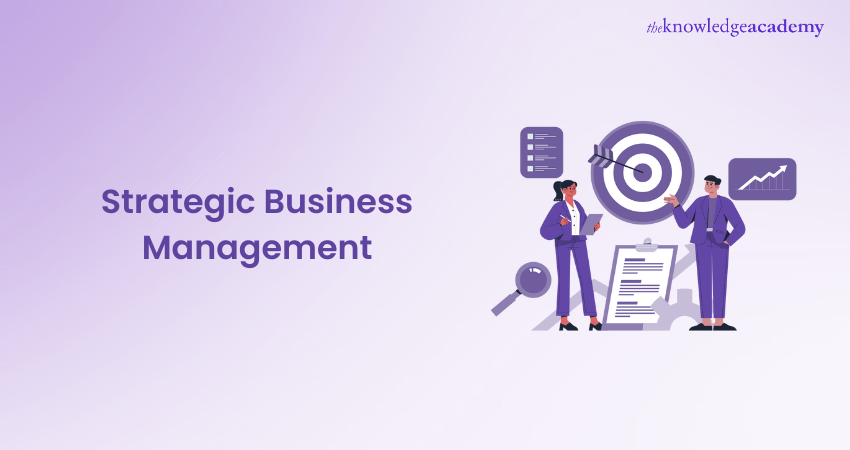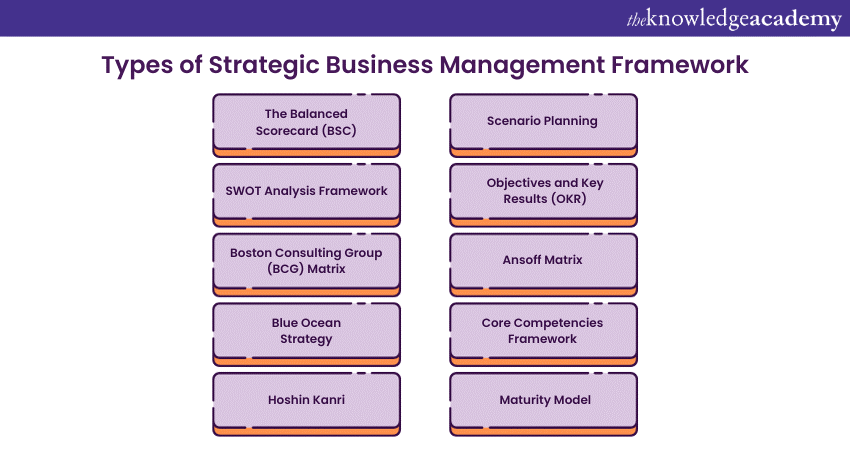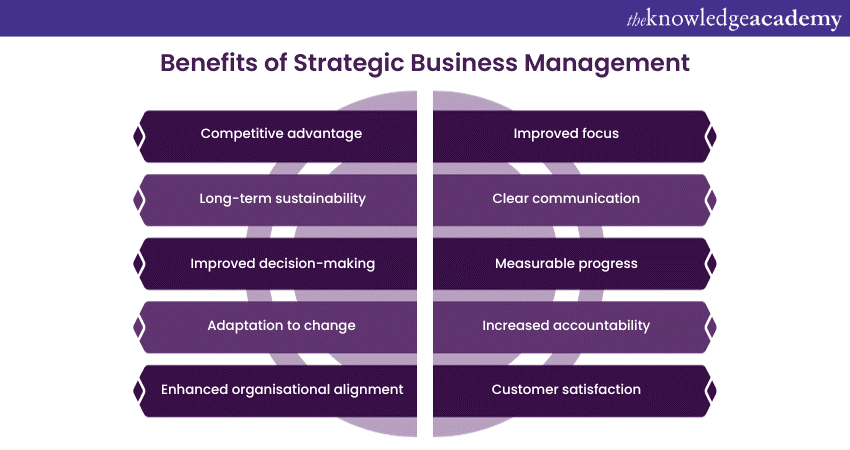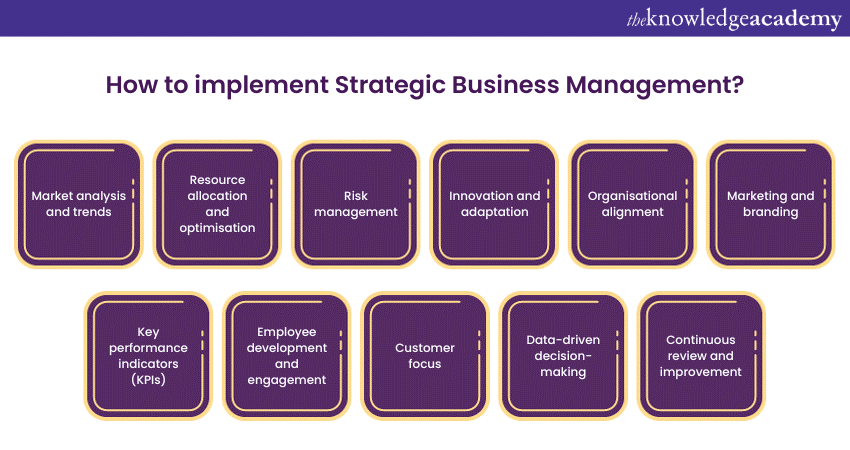We may not have the course you’re looking for. If you enquire or give us a call on 01344203999 and speak to our training experts, we may still be able to help with your training requirements.
Training Outcomes Within Your Budget!
We ensure quality, budget-alignment, and timely delivery by our expert instructors.

Nowadays, the business environment is highly competitive, and organisations constantly struggle to navigate uncertainty and adapt to change. This challenge brings the risk of falling behind in a rapidly evolving marketplace. This is where Strategic Business Management comes into play. It is a systematic approach that not only helps you survive but thrive in these turbulent times.
According to Statista, around 30,000 businesses in the UK will become insolvent in 2024, the second highest in the world. You can protect your business from such circumstances by implementing proper strategies like Strategic Business Management. But what is it, and how to implement it? Let's find out!
In this blog, you will learn about Strategic Business Management, its benefits and effective strategies for successfully implementing it.
Table of Contents
1) Understanding Strategic Business Management
2) Types of Strategic Business Management framework
3) Benefits of Strategic Business Management
4) Five stages of Strategic Business Management
5) Strategies for implement Strategic Business Management
6) Conclusion
Understanding Strategic Business Management
Strategic Business Management, often called Strategic Management, is the systematic and comprehensive approach organisations use to plan, execute, and evaluate their long-term goals and objectives. This vital process involves analysing internal and external factors to develop a clear and effective strategy for the future. Let's dive deeper into the key aspects of Strategic Business Management:
Strategic Business Management is about setting a direction for the organisation, making decisions on allocating its resources to pursue this direction and guiding the organisation in adapting to a constantly changing environment. It's the art of balancing the organisation's internal strengths and weaknesses with external opportunities and threats.
Types of Strategic Business Management Framework
Strategic Business Management can take various forms, and organisations often choose the best framework for their goals and needs. Here, we'll explore different types of Strategic Business Management Frameworks:

1) The Balanced Scorecard (BSC): The Balanced Scorecard is a widely adopted framework that aligns an organisation's activities with its vision and strategy. It measures performance from four key perspectives: financial, customer, internal processes, and learning and growth. This comprehensive approach helps organisations balance short-term and long-term goals while monitoring performance effectively.
2) SWOT Analysis Framework: Strengths, Weaknesses, Opportunities, Threats (SWOT) Analysis is a foundational framework that examines an organisation's internal strengths and weaknesses along with external opportunities and threats. It's a simple yet powerful tool that informs strategic decision-making by identifying areas for improvement and where the organisation excels.
3) Boston Consulting Group (BCG) Matrix: The Boston Consulting Group Matrix categorises a company's product portfolio into four quadrants: stars, question marks, cash cows, and dogs. This framework aids resource allocation, guiding decisions about investing in or divesting from different product lines.
4) Blue Ocean Strategy: The Blue Ocean Strategy is about creating uncontested market space by finding and serving a new customer base or offering unique value. It encourages innovation and differentiation to escape from intense competition and explore untapped markets.
5) Hoshin Kanri: Hoshin Kanri is a strategic planning methodology originating from Japan. It emphasises aligning company objectives with the goals of individual departments and employees. This ensures that everyone in the organisation works toward the same strategic objectives.
6) Scenario Planning: Scenario planning involves creating multiple future scenarios to anticipate different market conditions and challenges. Organisations use this framework to develop strategies to adapt to various potential outcomes.
7) Objectives and Key Results (OKR): OKR is a goal-setting framework that fosters organisational alignment and engagement. It sets clear, measurable objectives and key results to gauge progress and success, often quarterly or annually.
8) Ansoff Matrix: The Ansoff Matrix helps organisations consider their growth strategies. It focuses on market and product diversification by categorising strategies into market penetration, market development, product development, and diversification.
9) Core Competencies Framework: This framework revolves around identifying and leveraging an organisation's core competencies to gain a competitive advantage. It emphasises focusing on what the organisation does best and nurturing these unique capabilities.
10) Maturity Model: Maturity models, such as the Capability Maturity Model Integration (CMMI), help organisations assess their current state and set a path for continuous improvement. They focus on reaching higher maturity levels in various aspects of the business.
Selecting the right framework depends on an organisation's unique circumstances and strategic objectives. By understanding the different frameworks available, businesses can tailor their strategic management approach to achieve their desired outcomes.
Optimise your business for maximum efficiency and success with our Business Process Improvement Training – Sign up now!
Benefits of Strategic Business Management
Strategic Business Management offers a wide array of advantages that can significantly impact the success and sustainability of an organisation. Let's explore the key benefits of Strategic Business Management:

1) Competitive advantage: Strategic Business Management allows organisations to gain and maintain a competitive edge. By analysing internal strengths and weaknesses and external opportunities and threats, companies can identify areas where they excel and use them to outperform competitors.
2) Long-term sustainability: Strategic Business Management is all about planning for the long term. It ensures an organisation's viability and growth over time by enabling it to adapt to changing circumstances, mitigate risks, and seize opportunities as they arise.
3) Improved decision-making: The structured approach of strategic management encourages informed decision-making. Organisations base their choices on the defined strategy, reducing the risk of making impulsive or shortsighted decisions that might harm their prospects.
4) Adaptation to change: In today's fast-paced business landscape, adaptability is crucial. Strategic Business Management equips organisations to anticipate and respond to shifts in the market, technology, and consumer behaviour, ensuring they remain relevant and resilient.
5) Enhanced organisational alignment: Strategic management ensures that everyone within the organisation understands and supports the strategic direction. This alignment boosts morale and productivity and reduces internal conflicts.
6) Improved focus: Strategic management helps organisations stay focused on their priorities. It enables them to allocate resources and effort to high-priority initiatives that are in line with their strategic goals.
7) Clear communication: By defining a clear vision and mission and communicating them throughout the organisation, strategic management creates a shared sense of purpose, fostering unity and a common understanding of the organisation's direction.
8) Measurable progress: Strategic plans often include Key Performance Indicators (KPIs), allowing organisations to measure their progress objectively. This data-driven approach facilitates continuous improvement.
9) Increased accountability: Employees at all levels of the organisation understand their roles in achieving the strategic objectives. This accountability promotes a culture of responsibility and commitment.
10) Customer satisfaction: Customer-centric strategies help organisations better meet their customers' needs and expectations, leading to higher satisfaction and loyalty.
Overall, the benefits of Strategic Business Management are extensive and impactful. This process empowers organisations to outperform competitors in the long run.
Five Stages of Strategic Business Management
Strategic Business Management is a structured process that unfolds through five distinct stages. These stages are essential for developing and implementing an effective strategic plan. Here are the five stages:
1) Vision and mission development: At the outset, organisations define their vision and mission. The vision sets the future direction they aspire to move towards, while the mission articulates their purpose and how they intend to achieve that vision. These statements provide clarity and a sense of purpose for the entire organisation.
2) Environmental Analysis: This stage involves a comprehensive assessment of the organisation's internal strengths and weaknesses, as well as the external opportunities and threats in the business environment. The SWOT analysis is a foundational step, helping organisations identify their competitive advantages, challenges, and the market landscape.
3) Goal Setting and planning: With a clear understanding of their internal and external landscape, organisations set specific, measurable, achievable, relevant, and time-bound (SMART) goals. These SMART Goals align with their vision and mission and serve as the roadmap for the organisation's future. Planning, in this stage, involves defining the strategies and actions required to achieve these goals.
4) Implementation and resource allocation: Once the strategic plan is in place, it's time for execution. This stage focuses on the allocation of resources, including financial, human, and technological resources, to implement the strategies and actions outlined in the plan. Effective resource allocation is key to achieving the desired outcomes.
5) Evaluation and adaptation: Strategic Business Management doesn't end with implementation. Organisations continually evaluate their progress and performance against their strategic goals. Regular assessments help identify what's working and what's not. When necessary, adjustments are made to the strategy to adapt to changing market conditions, customer preferences, or unforeseen challenges.
These five stages are iterative, meaning that organisations often revisit and revise their strategies in an ongoing cycle. This adaptability ensures that the strategic plan remains relevant and effective in the face of evolving business dynamics. By following these stages, organisations can steer their operations in a direction that aligns with their long-term objectives and positions them for sustained success in a competitive world.
Elevate your business towards a sustainable future with our Business Sustainability Masterclass.
Strategies for implementing Strategic Business Management
Strategic Business Management is a dynamic process involving strategies to ensure its successful implementation and continuous improvement. Here are some key strategies to effectively implement Strategic Business Management in your organisation:

1) Market analysis and trends: Stay vigilant by monitoring industry trends, consumer preferences, and competitor actions. Regularly assess market dynamics to identify new opportunities and potential threats. This information is invaluable for strategic decision-making.
2) Resource allocation and optimisation: Allocate your resources wisely by investing in areas that align with your strategic goals. Ensure financial, human, and technological resources are optimised to support your strategic objectives effectively.
3) Risk management: Develop a comprehensive risk management plan that anticipates potential setbacks. Identify vulnerabilities and create contingency plans to mitigate risks, ensuring the organisation can adapt to unforeseen challenges.
4) Innovation and adaptation: Embrace change and encourage innovation within the organisation. Foster a culture of adaptability and continuous improvement. Be open to new technologies and methodologies to remain competitive and meet evolving customer needs.
5) Organisational alignment: Ensure that every member of the organisation understands and supports the strategic direction. Effective communication is key in aligning employees with the organisation's goals. This alignment enhances overall efficiency and productivity.
6) Marketing and branding: Develop and maintain a strong brand that resonates with your target audience. Effective branding and marketing strategies can significantly contribute to achieving your strategic objectives.
7) Key performance indicators (KPIs): Define and regularly measure key performance indicators (KPIs) aligned with your strategic goals. These metrics provide an objective way to gauge progress and identify improvement areas.
8) Employee development and engagement: Invest in the development and engagement of your workforce. Well-trained and motivated employees are more likely to contribute effectively to executing your strategic plan.
9) Customer focus: Keep a customer-centric approach at the core of your strategic management. Understand your customers' needs and expectations and tailor your strategies to meet them effectively. Satisfied customers drive business success.
10) Data-driven decision-making: Leverage data and analytics to make informed decisions. Data-driven insights can provide valuable information for refining strategies and adjusting as needed.
11) Continuous review and improvement: Regularly review and evaluate your strategic plan. Seek feedback from all levels of the organisation and stakeholders. Use these insights to make necessary adjustments and improvements to your strategies.
By implementing these strategies, your organisation can not only create a solid foundation for Strategic Business Management but also ensure that the process remains effective and adaptable in the ever-changing business landscape. When executed with a well-thought-out approach, strategic business management will enable your organisation to thrive and achieve long-term success.
Conclusion
We hope you read and understand everything about Strategic Business Management. It is the guiding light in a competitive, ever-changing business world. By embracing its principles, organisations can not only survive but thrive, setting a course for long-term excellence and resilience.
Unlock your leadership potential with our Management Training – Sign up today!
Frequently Asked Questions
Upcoming Business Skills Resources Batches & Dates
Date
 Business Process Improvement Training
Business Process Improvement Training
Fri 28th Jun 2024
Fri 23rd Aug 2024
Fri 25th Oct 2024
Fri 27th Dec 2024







 Top Rated Course
Top Rated Course



 If you wish to make any changes to your course, please
If you wish to make any changes to your course, please


